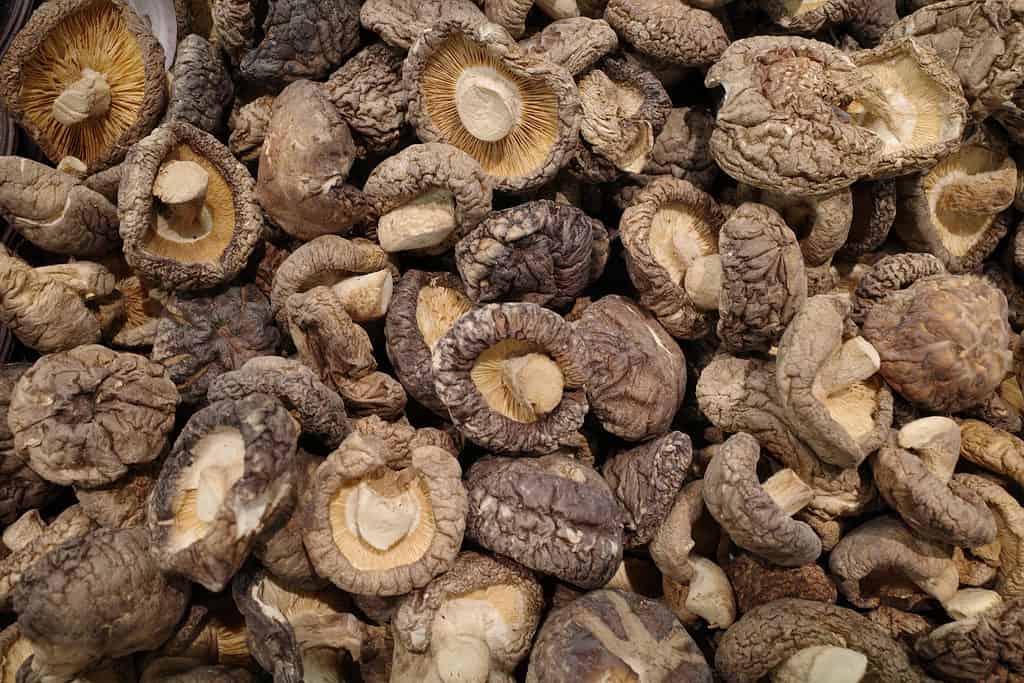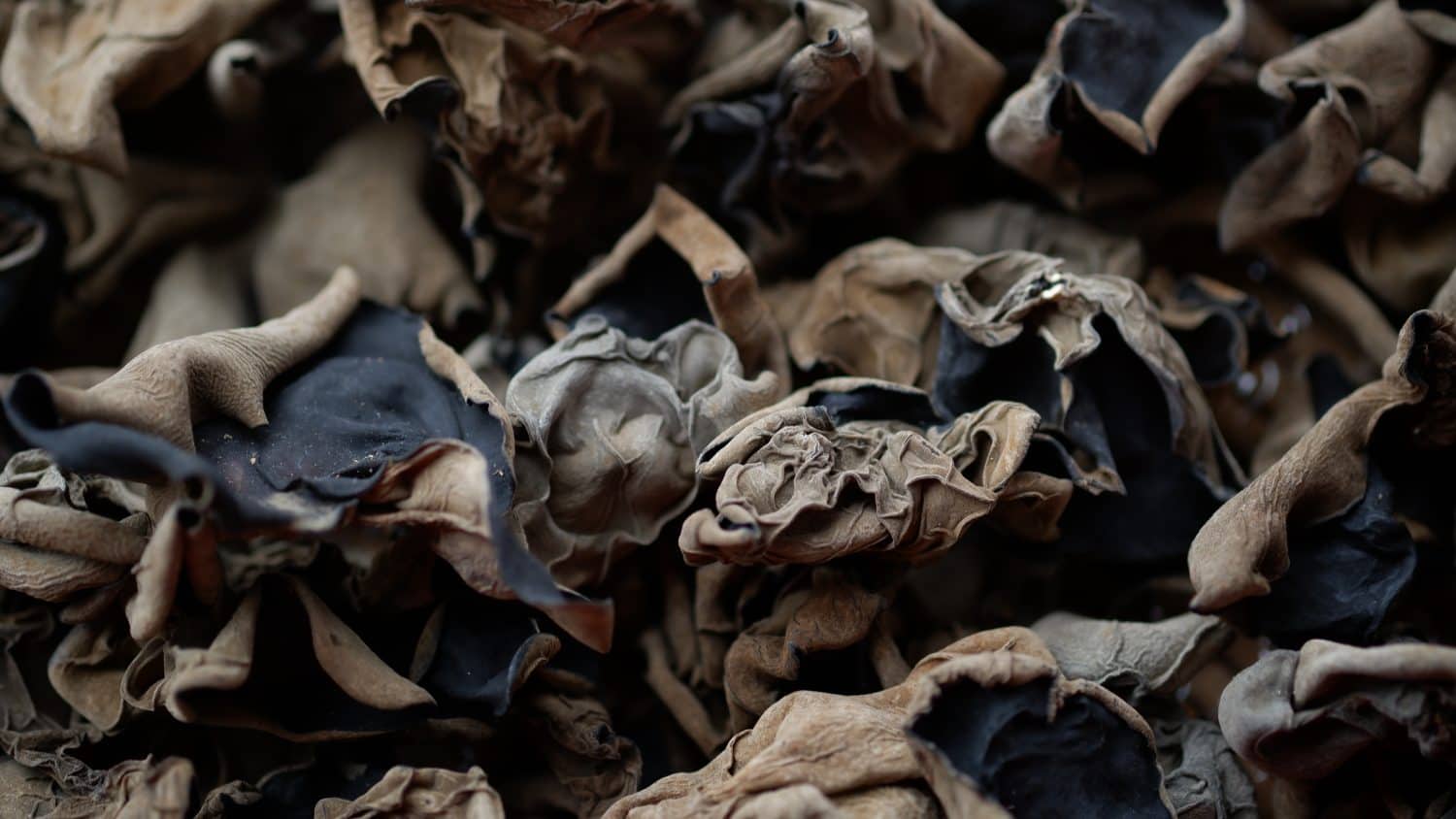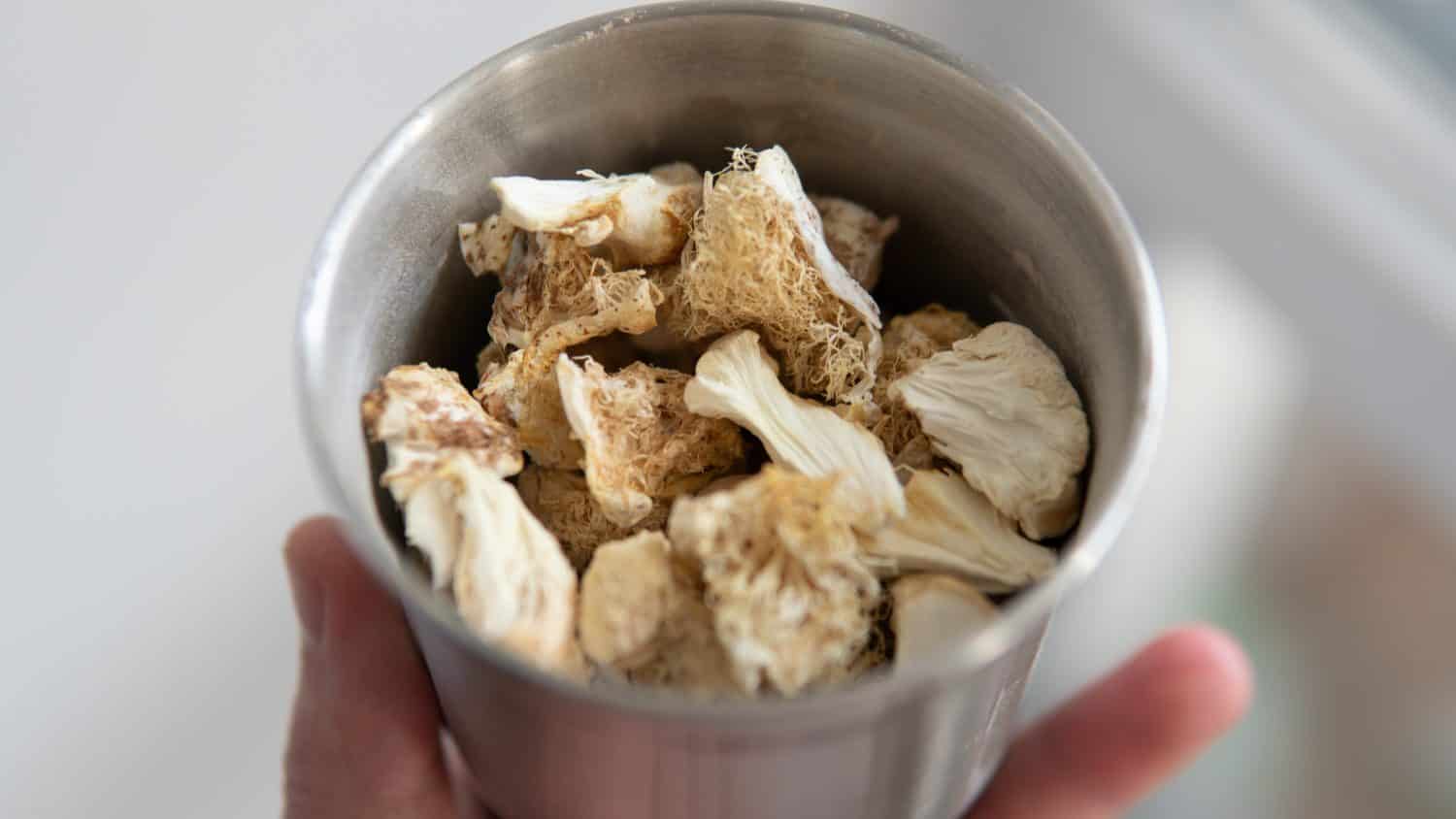Adding dried mushrooms to a savory dish is an excellent way to bring out a punch of flavor and add to the nutritional value of your meal. In the U.S., there are a handful of dried mushrooms that you can commonly find available at international grocers, farmer’s markets, and even some chain grocery stores. In this guide, we’ll cover four types of dried mushrooms you can typically find year-round in the U.S., health precautions, and popular culinary uses.
Read on to learn more.
1. Shiitake Mushrooms (Lentinula edodes)

Dried shiitake contains a so-called “umami enhancer” called Guanylate.
©Topnmp/Shutterstock.com
Prized for its meaty texture, deep umami, and nutty and earthy flavor, shiitake is among the top three cultivated mushrooms in the world. Native to temperate regions of East Asia, shiitake mushroom cultivators grow them in suitable environments worldwide. In the U.S., the Northeast is a particular hotspot for commercial shiitake cultivation.
While you can often find these delicious mushrooms fresh in health stores, international markets, and even some box grocery stores, you can also find them dried year-round. Global markets with East Asian representation often have dried shiitakes.
For many people, dried shiitake mushrooms pack an even more intense umami flavor than their fresh counterparts. If you are making a broth, stew, or curry, a popular preparation method is to soak the shiitakes in hot water for about half an hour to an hour and then use the mushroom-soaked water as a base for your stock. The flavor is wonderfully rich and savory. Then, you can either sauté the rehydrated mushrooms or cook them directly into the broth.
Make sure to cook rehydrated or fresh shiitake thoroughly. The consumption of undercooked or raw shiitake mushrooms can cause GI illness and a rare systemic dermatological condition known as shiitake dermatitis. It is also worth noting that some studies suggest that shiitakes, especially those grown in China, may contain trace amounts of heavy metals that should not be consumed in large quantities.
2. Types of Dried Mushrooms: Morels (Morchella spp.)

Dried morels cost $15 an ounce or more! It may be best to try and find them yourself if you know how to.
©Janny2/Shutterstock.com
Morels of the Morchella genus are highly sought-after gourmet mushrooms. They are typically only available fresh in the U.S. during spring and early summer. Otherwise, if you wish to buy morels, you’ll likely need to seek out dried specimens. Like shiitakes, many international and gourmet markets sell dried morels year-round.
The only morel species widely commercially cultivated is Morchella rufobrunnea, the blushing morel. Unlike other species in Morchella, M. rufobrunnea can grow without complicated tree associations. So, if you buy dried morels from your average grocery store and not from a specialty mushroom distributor, you’re likely purchasing M. rufobrunnea. The flavor profile of these mushrooms is wonderfully nutty, earthy, slightly buttery, and faintly smoky. They are excellent additions to a creamy soup, clear broth soup, vegetable stew, fettuccini dish, mushroom fried rice, and more.
It’s crucial to thoroughly cook rehydrated and fresh morels before consuming. Raw or undercooked morels can cause neurological effects and GI illness. In one case, they have even been associated with a widespread poisoning of restaurant patrons, including hospitalizations and two deaths.
3. Black Wood Ear (Auricularia heimuer)

Black wood ear is similar to regular wood ear in taste and texture.
©wisely/Shutterstock.com
Dried black wood ear (Auricularia heimuer) is a popular ingredient in Chinese dishes. This fungus is typically available year-round at international and Asian grocery stores. It is one of the most commercially cultivated mushrooms in East Asia.
This mushroom is relatively neutral in taste, but it readily absorbs flavors. As such, folks often use this fungus in soups where it can absorb the flavors of the broth. For those in the U.S., one of the most famous dishes featuring the black wood ear is traditionally made with hot and sour soup. Another typical dish that features this fungus is a wood ear mushroom salad. In both dishes, you’ll want to rehydrate this dried mushroom for 30 minutes to an hour before cooking and adding it to the meal.
4. Types of Dried Mushrooms: Lion’s Mane (Hericium erinaceus)

Lion’s mane also goes by the names “pom pom,” “monkey head,” and “bearded
hedgehog
.
©Kyrylo Vasyliev/Shutterstock.com
In the U.S., lion’s mane (Hericium erinaceus) is perhaps most well-known for its purported medicinal benefits. However, it’s also simply divine in dried and fresh culinary uses. Lion’s mane is native to temperate habitats of North America, Europe, and Asia. It is foraged and cultivated throughout these regions.
In the U.S., you can find fresh lion’s mane throughout the year. You can purchase them at farmers’ markets and international and gourmet grocery stores. Dried lion’s mane is most commonly found at East Asian food markets. You can also order dried lion’s mane online year-round.
When rehydrated and cooked, lion’s mane makes an incredible meat alternative. You’ll want to soak dried lion’s mane in warm water for about 30 minutes. Afterward, they should be plump and ready to use in various dishes. A celebrated vegan chef, Derek Sarno, has created a few delicious recipes for mouth-watering lion’s mane steaks. Lion’s mane is also fabulous in seafood dishes and an excellent substitute for crab cakes.
The photo featured at the top of this post is © Fotema/Shutterstock.com
The information presented on or through the Website is made available solely for general informational purposes. We do not warrant the accuracy, completeness, or usefulness of this information. Any reliance you place on such information is strictly at your own risk. We disclaim all liability and responsibility arising from any reliance placed on such materials by you or any other visitor to the Website, or by anyone who may be informed of any of its contents. None of the statements or claims on the Website should be taken as medical advice, health advice, or as confirmation that a plant, fungus, or other item is safe for consumption or will provide any health benefits. Anyone considering the health benefits of particular plant, fungus, or other item should first consult with a doctor or other medical professional. The statements made within this Website have not been evaluated by the Food and Drug Administration. These statements are not intended to diagnose, treat, cure or prevent any disease.
Thank you for reading! Have some feedback for us? Contact the AZ Animals editorial team.







